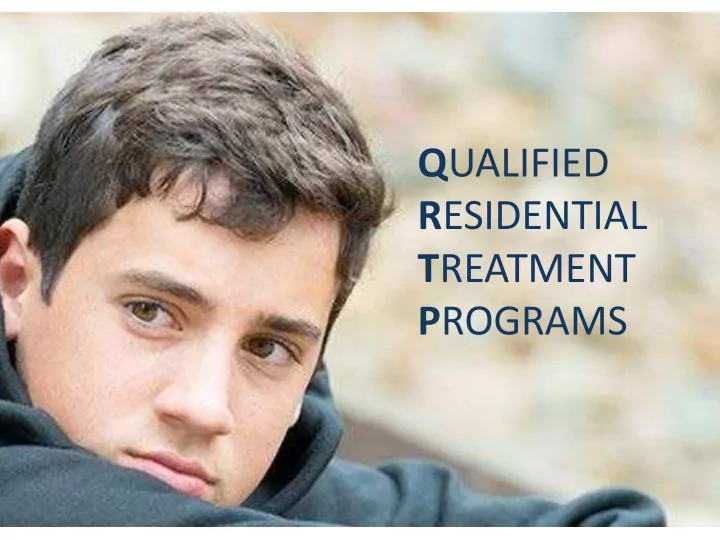

Q UALIFIED R ESIDENTIAL T REATMENT P ROGRAMS
Family First Prevention and Services Act P.L. 115-123 • Limits Title IV-E foster care payments for placements that are not foster family homes • Creates QRTPs - a category of non-family foster home settings • Establishes requirements for QRTPs to receive IV-E payments • Requires judicial review of QRTP placements
Foster Care Funding • Title IV-E foster care payments limited to the following settings: – Licensed foster family home - 6 or fewer children – Child-care institution: • Qualified Residential Treatment Program (QRTP) • Program for prenatal, post-partum, or parenting youth. • Supervised independent living for youth ages 18 and older • Residential care for youth found to be, or at risk of becoming, sex trafficking victims – Family-based residential substance abuse treatment facility
WA
Washington State HB 1900 • Effective October 1, 2019 – Applies to all QRTP placements made on and after Oct 1 • Defines QRTP – Program licensed as group care facility – Qualifies for Family First funding – Trauma-informed treatment model – Meets treatment needs identified by individualized assessment • Redefines “social study” requirements for children placed in QRTP – Include individualized assessment of child’s needs – Provide updates for court review of placement
Washington State HB 1900 • Establishes court oversight requirements • Hearing required within 60 days of QRTP placement • Review assessment • Approve or disapprove placement • Ongoing review of child’s status in QRTP with written findings at every review and permanency planning hearing
QRTP Requirements for IV-E Funds • Trauma informed treatment model • Provides treatment identified by individualized QRTP assessment • Nurse and clinical staff on site 24/7 • Licensed and nationally accredited • Family participation in treatment • Maintain family contact, including siblings • Discharge planning and aftercare supports
QRTP Assessment • Assessed within 30 days placement in QRTP • Conducted by a “Qualified Individual” – FFPSA - trained professional or licensed clinician who is not a state employee or affiliated with any placement setting – DCYF – requested waiver by HHS to allow Regional BRS Managers to serve as Qualified Individuals • Assessment tool – Age appropriate, evidence-based, validated – WA uses Children’s Functional Assessment Rating Scale (CFARS)
QRTP Assessment • Assessment includes – Strengths and needs of child – Determination re: where child’s needs can best be met • Document whether or not a family or foster home can meet needs – if not, identify which setting will provide most effective and appropriate level of care • Least restrictive environment • Consistent with child’s permanency plan
QRTP Assessment • If QRTP is not appropriate – State has 30 days to transition child to a placement that can better address the child’s needs – If it takes longer or state chooses to continue the placement, the state forgoes federal foster care maintenance funding for duration of that placement
Federal Assessment Requirements • Assessment must be conducted in conjunction with child’s family and permanency team, including: – All appropriate bio family members, relatives, fictive kin – Professionals who are a resource for the family (teachers, medical and mental health providers, or clergy) – If child is 14 or older s/he may select 2 people to serve on team
Qualified Individual Report • Report includes Results of the Children’s Functional Assessment Rating Scale (“CFARS”) • Courts should only see QRTP Assessment reports with a score of 60 or higher. • Narrative written by the Qualified Individual • describing why QRTP is the best setting to meet the youth’s current level of needs
QRTP Timeline Day 1 - Child placed in group care facility (“BRS facility”). Within 30 days – Assessment per RCW 13.34.420. Between 30-60 days (and beyond) – Social Study to include the Assessment, and additional information to enable court determinations. RCW 13.34.430(4)
QRTP Timeline By 60 days – per RCW 13.34.425 the court: • Considers Assessment and related documentation • Determines whether placement in foster care can meet the child’s needs or if placement in another available placement setting best meets the child’s needs in the least restrictive environment; and • Approve or disapprove the child’s placement in the QRTP.
On-Going Agency & Court Oversight At each Review (RCW 13.34.138(2)(c)(iv) and Permanency Planning RCW 13.34.145(4)(c) hearing thereafter, court must make findings related to the ongoing need for QRTP placement • As long as the child remains in QRTP over 60 days, assigned social worker must update social study • At every status review and permanency hearing court must make written findings
The child remains placed in a Qualified Residential Treatment Program. [ ] [ ] Ongoing assessment of the child’s strengths and needs continues to support the determination that the child’s needs cannot be met through placement in a foster family home. [ ] The child’s placement provides the most effective and appropriate level of care in the least restrictive environment. [ ] The placement in a Qualified Residential Treatment Program is consistent with the child’s short and long term goals as stated in the child’s permanency plan. [ ] The Qualified Residential Treatment Facility will meet the treatment or service needs of the child, as follows: _______________________________________________________________ [ ] _____________________________ [ ] months [ ] days is the expected time the child will need the treatment or services provided by the Qualified Residential Treatment Program. [ ] The Department has made the efforts to prepare the child for return home or placement with a relative, legal guardian, adoptive parent, or foster family home, as follows: _______________________________________________________________
Forms Two new forms • Motion for Court Approval of Placement in Qualified Residential Treatment Program (JU 03.0450) • Order on Motion for Court Approval of Placement in Qualified Residential Treatment Program (JU 03.0460) Changes to two existing forms • Order after Hearing: First Dependency Review / Dependency Review / Permanency Planning (JU 03.0500) • Legally Free – Order after Hearing Dependency Review Hearing Order / Permanency Planning Hearing Order (JU 03.0560)
Recommend
More recommend